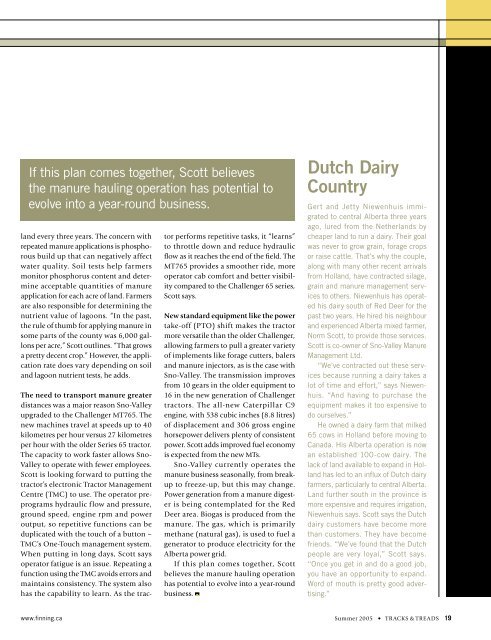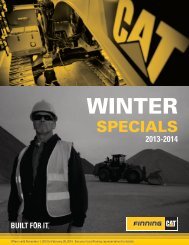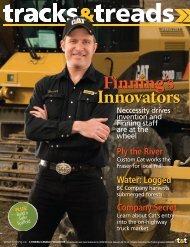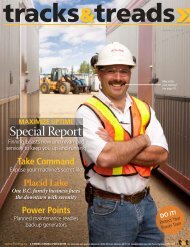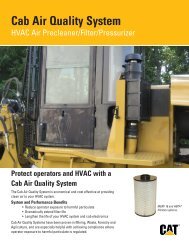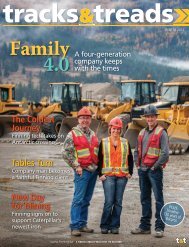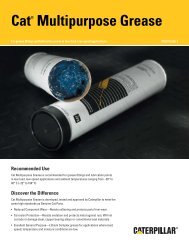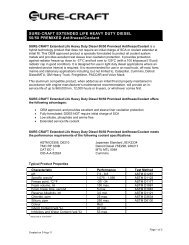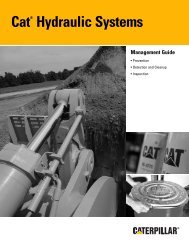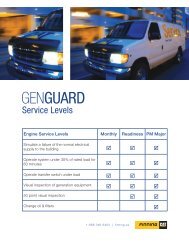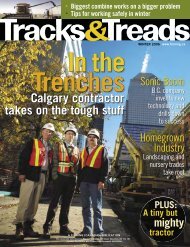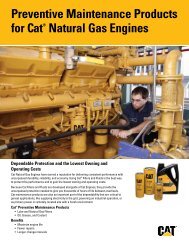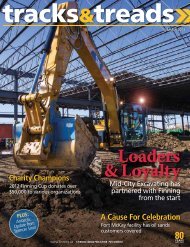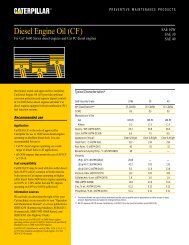Caterpillar - Finning Canada
Caterpillar - Finning Canada
Caterpillar - Finning Canada
Create successful ePaper yourself
Turn your PDF publications into a flip-book with our unique Google optimized e-Paper software.
If this plan comes together, Scott believesthe manure hauling operation has potential toevolve into a year-round business.land every three years. The concern withrepeated manure applications is phosphorousbuild up that can negatively affectwater quality. Soil tests help farmersmonitor phosphorus content and determineacceptable quantities of manureapplication for each acre of land. Farmersare also responsible for determining thenutrient value of lagoons. “In the past,the rule of thumb for applying manure insome parts of the county was 6,000 gallonsper acre,” Scott outlines. “That growsa pretty decent crop.” However, the applicationrate does vary depending on soiland lagoon nutrient tests, he adds.The need to transport manure greaterdistances was a major reason Sno-Valleyupgraded to the Challenger MT765. Thenew machines travel at speeds up to 40kilometres per hour versus 27 kilometresper hour with the older Series 65 tractor.The capacity to work faster allows Sno-Valley to operate with fewer employees.Scott is looking forward to putting thetractor’s electronic Tractor ManagementCentre (TMC) to use. The operator preprogramshydraulic flow and pressure,ground speed, engine rpm and poweroutput, so repetitive functions can beduplicated with the touch of a button –TMC’s One-Touch management system.When putting in long days, Scott saysoperator fatigue is an issue. Repeating afunction using the TMC avoids errors andmaintains consistency. The system alsohas the capability to learn. As the tractorperforms repetitive tasks, it “learns”to throttle down and reduce hydraulicflow as it reaches the end of the field. TheMT765 provides a smoother ride, moreoperator cab comfort and better visibilitycompared to the Challenger 65 series,Scott says.New standard equipment like the powertake-off (PTO) shift makes the tractormore versatile than the older Challenger,allowing farmers to pull a greater varietyof implements like forage cutters, balersand manure injectors, as is the case withSno-Valley. The transmission improvesfrom 10 gears in the older equipment to16 in the new generation of Challengertractors. The all-new <strong>Caterpillar</strong> C9engine, with 538 cubic inches (8.8 litres)of displacement and 306 gross enginehorsepower delivers plenty of consistentpower. Scott adds improved fuel economyis expected from the new MTs.Sno-Valley currently operates themanure business seasonally, from breakupto freeze-up, but this may change.Power generation from a manure digesteris being contemplated for the RedDeer area. Biogas is produced from themanure. The gas, which is primarilymethane (natural gas), is used to fuel agenerator to produce electricity for theAlberta power grid.If this plan comes together, Scottbelieves the manure hauling operationhas potential to evolve into a year-roundbusiness.Dutch DairyCountryGert and Jetty Niewenhuis immigratedto central Alberta three yearsago, lured from the Netherlands bycheaper land to run a dairy. Their goalwas never to grow grain, forage cropsor raise cattle. That’s why the couple,along with many other recent arrivalsfrom Holland, have contracted silage,grain and manure management servicesto others. Niewenhuis has operatedhis dairy south of Red Deer for thepast two years. He hired his neighbourand experienced Alberta mixed farmer,Norm Scott, to provide those services.Scott is co-owner of Sno-Valley ManureManagement Ltd.“We’ve contracted out these servicesbecause running a dairy takes alot of time and effort,” says Niewenhuis.“And having to purchase theequipment makes it too expensive todo ourselves.”He owned a dairy farm that milked65 cows in Holland before moving to<strong>Canada</strong>. His Alberta operation is nowan established 100-cow dairy. Thelack of land available to expand in Hollandhas led to an influx of Dutch dairyfarmers, particularly to central Alberta.Land further south in the province ismore expensive and requires irrigation,Niewenhuis says. Scott says the Dutchdairy customers have become morethan customers. They have becomefriends. “We’ve found that the Dutchpeople are very loyal,” Scott says.“Once you get in and do a good job,you have an opportunity to expand.Word of mouth is pretty good advertising.”www.finning.ca Summer 2005 • TRACKS & TREADS 19


